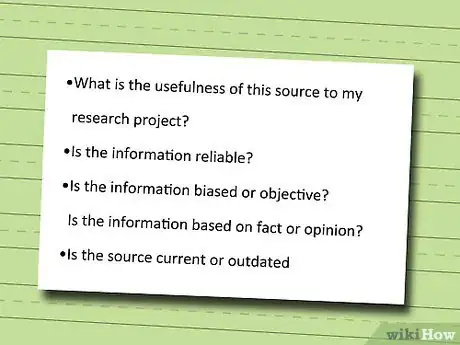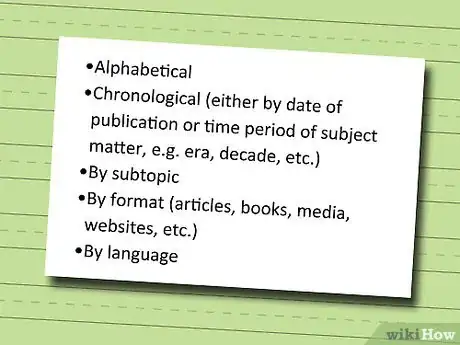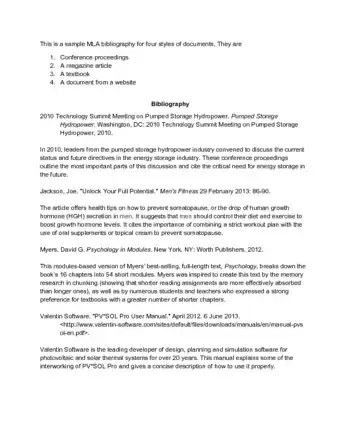This article was co-authored by Christopher Taylor, PhD. Christopher Taylor is an Adjunct Assistant Professor of English at Austin Community College in Texas. He received his PhD in English Literature and Medieval Studies from the University of Texas at Austin in 2014.
wikiHow marks an article as reader-approved once it receives enough positive feedback. In this case, 90% of readers who voted found the article helpful, earning it our reader-approved status.
This article has been viewed 123,483 times.
While a traditional bibliography only lists citations for sources, an annotated bibliography provides a summary and evaluation of the sources. Although it might sound challenging, making an annotated bibliography is not that complicated. For each of your sources, you'll include a short paragraph called an annotation, which explains the strengths and weaknesses of the source, as well as its relevance.
Steps
Writing Annotations for Your Sources
-
1Choose your sources. It's best to have your sources before you start annotating so you'll know what your research shows about your topic. Make sure you have enough sources to satisfy the requirements of the assignment. Similarly, check that all of your sources are appropriate.
- Your annotated bibliography should provide an overview of the research on your topic, as well as the direction your project is taking, similar to a road map.
-
2Determine the needs of your project or assignment. Some annotated bibliographies are meant to summarize the sources that you have found. Others will also evaluate the main points of the sources. It's common for your annotations to both summarize and evaluate. The needs of your annotated bibliography depend on your project or assignment. Be in touch with your teacher or advisor for guidance.[1]Advertisement
-
3Summarize each source. Describe the source's approach to the topic and the main points that it makes. Ask yourself: What content does the source discuss? What is the source arguing? What does it want me to learn or believe? Think of a summary as how you would describe the source if someone asked you what it was about.[2]
- The length of the summaries will depend on your project’s needs as well as the type of source.
- For instance, an article might be summarized in a few sentences, while the summary of a book might take a page or more in some cases.
-
4Provide evaluations in your annotations. If your bibliography is supposed to go beyond summarizing your sources, the next thing to do is to consider their strengths and weaknesses. Ask yourself questions like:[3]
- Is this source useful for me or other scholars? Why?
- What is the primary way that this source helps us understand the topic better?
- How does the source build on or depart from prior knowledge and research on the topic?
- Are there any aspects of the source that seem underdeveloped, lacking, misleading, or wrong?
- Is this source reliable? Is it written by someone who is an authority in the field?
- Does the source show any obvious biases?
-
5Describe how each source compares to the others. Since an annotated bibliography is meant to give an overview of research in a field, it helps to understand how the sources stand in relation to each other. This allows you to demonstrate current thought on the topic. Think about things like:[4]
- Are any of your sources better than others in some way (more comprehensive, nuanced, authoritative, etc.)?
- Do the sources have any overlap in terms of content, approach, or argument?
- What important differences are there between the sources?
- Do any of the sources quote from, cite, or respond to the ideas of others?
-
6Reflect on how each source fits into your research. Sometimes, annotated bibliographies are stand-alone works. Very often, however, they are part of a larger research project. If this is the case for you, spend a little time thinking about how each source contributes to your project. Ask yourself: How will I use this source in my project?[5]
- Will I draw facts or important quotations from it?
- Will I use its findings to support my own?
- Will I argue with its central claim, or agree with it?
- Will I borrow its methods for my own analysis?
Choosing and Organizing Your Citations
-
1Select high-quality sources. An annotated bibliography is designed to give an overview of research on a topic. It might be selective, choosing just a few representative sources. Or, it might be comprehensive, designed to summarize all of the major findings on a topic. Either way, the sources should be reliable, high quality ones. You’ll impress your teacher if you stick to these![6]
- Generally, look for scholarly sources published in academic journals and by authoritative publishers, or established, reputable websites.
- If you are writing an annotated bibliography for a class, ask your teacher or a librarian for help finding good sources.
-
2Provide full citations for each source. In addition to your annotations, you should provide the basic bibliographic information for each source: its author, title, date, etc. The exact citation style you should use (MLA, APA, Chicago, or something else) depends on your project. Ask your teacher or advisor if you aren’t sure which style to use.[7]
-
3Format your bibliography. Most of the time, you want to create an annotated bibliography as a series of entries. At the start of each entry, give the full citation for the work. Then, follow up with your annotations that summarize and evaluate your sources, in paragraph form.[8]
- For many fields and projects, the annotations will be about a paragraph long. In some cases, however, they’ll need to be longer. Ask if you aren’t sure.
-
4Organize your entries. In many cases, annotated bibliographies are arranged alphabetically, so that they are ordered based on the authors’ last names. Sometimes, however, another organizational style might make sense and be acceptable to your teacher or field. For instance:[9]
- You could arrange your entries chronologically if you want to stress developments in your topic over time.
- You could arrange your sources based on subtopics, if there are groups of them that could be clustered together.
- If you have sources in different formats (books, articles, websites, films), you could also arrange them accordingly.
Sample Annotated Bibliographies
Community Q&A
-
QuestionDo I list the primary source and the secondary sources together or separately?
 AneHaneCommunity AnswerYou group them separately so whoever reads your paper has an easier time of understanding what literature was used and how. Even if you only include one type (only primary sources without secondary sources and vice versa), you should make sure to always write it down. Depending on your field of study, dictionaries and the like are seen as their own category. If you are still unsure, ask your teacher about special cases like these.
AneHaneCommunity AnswerYou group them separately so whoever reads your paper has an easier time of understanding what literature was used and how. Even if you only include one type (only primary sources without secondary sources and vice versa), you should make sure to always write it down. Depending on your field of study, dictionaries and the like are seen as their own category. If you are still unsure, ask your teacher about special cases like these.
References
- ↑ https://owl.english.purdue.edu/owl/resource/614/1/
- ↑ https://owl.english.purdue.edu/owl/resource/614/1/
- ↑ https://owl.english.purdue.edu/owl/resource/614/1/
- ↑ https://owl.english.purdue.edu/owl/resource/614/1/
- ↑ https://owl.english.purdue.edu/owl/resource/614/1/
- ↑ http://lib.skidmore.edu/library/index.php/li371-annotated-bib
- ↑ https://lib.calpoly.edu/help-and-support/write-an-annotated-bibliography/
- ↑ https://owl.english.purdue.edu/owl/resource/614/1/
- ↑ http://lib.skidmore.edu/library/index.php/li371-annotated-bib
About This Article
To write an annotated bibliography, start by gathering all the source material you used in your project and choosing the most high-quality work to include, such as scholarly journals or reputable websites. For each source, provide a full citation according to the style manual you’re using, then include a paragraph analyzing the source and explaining how it fits into your research. Finally, organize your source entries chronologically if you want to emphasize the development of your topic, or alphabetically by the authors’ last names to keep it simple. For tips on some questions to address when you’re evaluating your sources, keep reading.


































































